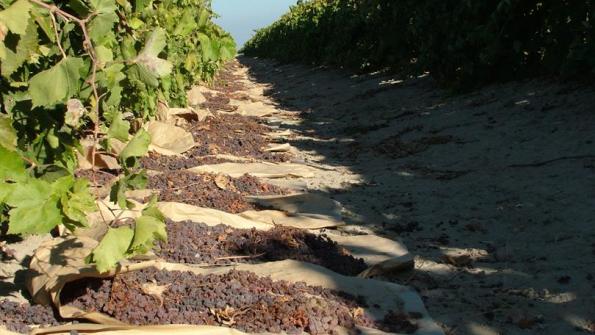
Two weeks after mechanically-harvesting his 310 acres of Thompson Seedless grapes and laying them on continuous trays to dry, Mitch Sangha started picking them up on Sept. 14. With dry weather forecast in his area through the end of the month, he expects to have all his 2015 crop off the ground by Sept. 25.
“Like the almond and cherry crops around here, the raisins were ready about a week earlier than usual this year,” says Sangha, who farms near Del Rey in Fresno County. “Yields appear to be up about 10 percent from last year, and the quality of the raisins looks pretty good.”
This is the second season he’s picked his grapes with machines. The move was prompted by the continued increased cost of harvesting them by hand. About half the revenue he was making went to paying for labor.
That’s one of the reasons he began pulling out 40 acres of vines and replanting them to almond trees in 2012. Sangha, who’s been growing almonds for the past two decades, now has 250 acres of the trees, mostly Nonpareil and Monterey. “I can gross about three times as much money per acre with almonds with much less labor as with raisins,” he says.
Next year, he plans to be one of the earlier growers to plant a new self-pollinizing variety of almonds. It’s designed to reduce the need for bees to pollinate the crop, he adds.
The unusually warm and dry weather at the start of season, accelerated insect growth and development in his fields this year. As a result, pressure in his vineyards from mites began building earlier and heavier than usual, Sanga notes. Normally, he can control this pest with one insecticide application. This year he had to spray them twice, once in early May and again in July.
He was able to control powdery mildew with his normal program of alternating sulfur applications with fungicide treatments.
As of mid-September, the Raisin Bargaining Association and packers were negotiating the price for this year’s raisin crop. Like other growers in the state, Sangha looks for the weather-related drop in the size of Turkey’s raisin production this year to impact the price of California’s 2015 raisin crop.
“We’re waiting anxiously, hoping the price goes up,” he says. “The smaller crop in Turkey, a main competitor, should help better match world supply with demand. However, if the raisin prices do go up at the supermarket, our industry needs to explain to consumers that higher prices will enable growers to better afford to continue producing raisins in the future.”
About the Author(s)
You May Also Like




